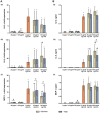Effect of Titanium and Zirconia Nanoparticles on Human Gingival Mesenchymal Stromal Cells
- PMID: 36077419
- PMCID: PMC9456558
- DOI: 10.3390/ijms231710022
Effect of Titanium and Zirconia Nanoparticles on Human Gingival Mesenchymal Stromal Cells
Abstract
Nano- and microparticles are currently being discussed as potential risk factors for peri-implant disease. In the present study, we compared the responses of human gingival mesenchymal stromal cells (hG-MSCs) on titanium and zirconia nanoparticles (<100 nm) in the absence and presence of Porphyromonas gingivalis lipopolysaccharide (LPS). The primary hG-MSCs were treated with titanium and zirconia nanoparticles in concentrations up to 2.000 µg/mL for 24 h, 72 h, and 168 h. Additionally, the cells were treated with different nanoparticles (25−100 µg/mL) in the presence of P. gingivalis LPS for 24 h. The cell proliferation and viability assay and live−dead and focal adhesion stainings were performed, and the expression levels of interleukin (IL)-6, IL-8, and monocyte chemoattractant protein (MCP)-1 were measured. The cell proliferation and viability were inhibited by the titanium (>1000 µg/mL) but not the zirconia nanoparticles, which was accompanied by enhanced apoptosis. Both types of nanoparticles (>25 µg/mL) induced the significant expression of IL-8 in gingival MSCs, and a slightly higher effect was observed for titanium nanoparticles. Both nanoparticles substantially enhanced the P. gingivalis LPS-induced IL-8 production; a higher effect was observed for zirconia nanoparticles. The production of inflammatory mediators by hG-MSCs is affected by the nanoparticles. This effect depends on the nanoparticle material and the presence of inflammatory stimuli.
Keywords: dental implants; human gingival mesenchymal stromal cells; nanoparticles; titanium; zirconia.
Conflict of interest statement
The authors declare no conflict of interest.
Figures







Similar articles
-
Effect of implant surface material and roughness to the susceptibility of primary gingival fibroblasts to inflammatory stimuli.Dent Mater. 2020 Jun;36(6):e194-e205. doi: 10.1016/j.dental.2020.04.003. Epub 2020 Apr 30. Dent Mater. 2020. PMID: 32360041
-
Dual response of fibroblasts viability and Porphyromonas gingivalis adhesion on nanostructured zirconia abutment surfaces.J Biomed Mater Res A. 2022 Oct;110(10):1645-1654. doi: 10.1002/jbm.a.37414. Epub 2022 Jun 8. J Biomed Mater Res A. 2022. PMID: 35676876
-
Response of Human Mesenchymal Stromal Cells from Periodontal Tissue to LPS Depends on the Purity but Not on the LPS Source.Mediators Inflamm. 2020 Jul 2;2020:8704896. doi: 10.1155/2020/8704896. eCollection 2020. Mediators Inflamm. 2020. PMID: 32714091 Free PMC article.
-
Porphyromonas gingivalis lipopolysaccharide signaling in gingival fibroblasts-CD14 and Toll-like receptors.Crit Rev Oral Biol Med. 2002;13(2):132-42. doi: 10.1177/154411130201300204. Crit Rev Oral Biol Med. 2002. PMID: 12097356 Review.
-
Human gingival fibroblast proliferation on materials used for dental implant abutments: a systematic review.Int J Prosthodont. 2021 November/December;34(6):811–828. doi: 10.11607/ijp.7388. Epub 2021 Feb 19. Int J Prosthodont. 2021. PMID: 33616578
Cited by
-
Comparative analysis of gingival crevicular fluid and peri-implant crevicular fluid by mid-infrared spectroscopy: a split mouth study.Clin Oral Investig. 2025 May 20;29(6):305. doi: 10.1007/s00784-025-06382-6. Clin Oral Investig. 2025. PMID: 40392311 Free PMC article.
-
Gingival mesenchymal stem cells: Biological properties and therapeutic applications.J Oral Biol Craniofac Res. 2024 Sep-Oct;14(5):547-569. doi: 10.1016/j.jobcr.2024.07.003. Epub 2024 Jul 13. J Oral Biol Craniofac Res. 2024. PMID: 39108352 Free PMC article.
-
Development and validation of a multiple myeloma diagnostic model based on systemic lupus erythematosus-associated genes and identification of specific genes.Discov Oncol. 2025 May 18;16(1):803. doi: 10.1007/s12672-025-02555-7. Discov Oncol. 2025. PMID: 40382732 Free PMC article.
-
Osseointegration and osteoimmunology in implantology: assessment of the immune sustainability of dental implants using advanced sonographic diagnostics: research and case reports.J Int Med Res. 2024 Jan;52(1):3000605231224161. doi: 10.1177/03000605231224161. J Int Med Res. 2024. PMID: 38259068 Free PMC article.
-
Expression of Interleukin-1β and Histological Changes of the Three-Dimensional Oral Mucosal Model in Response to Yttria-Stabilized Nanozirconia.Materials (Basel). 2023 Mar 1;16(5):2027. doi: 10.3390/ma16052027. Materials (Basel). 2023. PMID: 36903142 Free PMC article.
References
MeSH terms
Substances
LinkOut - more resources
Full Text Sources
Medical
Miscellaneous

